- 1College of Physics and Electronic Engineering, Qilu Normal University, Jinan, China
- 2Purple Mountain Observatory, Chinese Academy of Sciences, Nanjing, China
- 3School of Astronomy and Space Science, University of Science and Technology of China, Hefei, China
The single-lined spectroscopic binaries (SB1s) are composed of two components with large difference in masses and in physical properties. The orbital and physical parameters of a large number of such binary systems are unknown due to lack of necessary observations. Compared with SB2s, SB1s can provide much more stringent constraint to stellar evolutionary models at a single age. Besides, the fainter components of SB1s are likely to be compact celestial objects, such as a black hole or a neutron star, it is therefore interesting to determine their masses and physical properties. CSST provides an excellent opportunity to study SB1s especially nearby ones, since it can detect astrometric wobble at milliarcsecond level. This implies that if the motion of the visible components can be detected, the full motion of the SB1s can be determined. In this paper, we aim to analyse the ability of CSST to improve the orbital solutions of nearby SB1s based on the available data by adding simulated CSST data of different observation times. The orbital solutions of binaries determined from non-single-star orbital models for sources compatible with combined astrometric + single lined spectroscopic orbital model of Gaia DR3 are served as the research sample to reproduce the orbital elements by fitting simulated CSST data.
1 Introduction
Mass is the most important parameter of a star in deciding its physical state and evolution, and the only reliable way to determine this parameter is the orbital determination of a binary. Besides, binaries play a fundamental role in the evolution of stellar populations in galaxies. Specially, the two components of single-lined spectroscopic binaries (SB1s) has large difference in masses as well as physical properties. Thus, the two components of SB1s could provide further stringent constraints to stellar evolutionary models compared to double lined spectroscopic binaries (SB2s). Furthermore, the SB1s may have pulsar, brown dwarf or planet secondaries (Kürster et al., 2008; Stefanik et al., 2011). Therefore, it is important to determine the orbital solutions and masses of the components of SB1s.
The orbital and physical parameters of a large number of SB1s are unknown and limited by the previous observation. The release of Hipparcos data made the determination of the astrometric orbital for a part of SB1s realized. With Hipparcos Intermediate Astrometric Data (HIAD) and revised HIAD (Esa, 1997; van Leeuwen, 2007), the astrometric orbits of many spectroscopic binaries are determined (Pourbaix and Boffin, 2003; Jancart et al., 2005; Ren and Fu, 2010; Ren and Fu, 2013) based on SB9(The ninth catalogue of spectroscopic binary orbits) which collects the published orbital information of spectroscopic binaries (Pourbaix et al., 2004). Then, the physical properties of the secondaries are discussed.
The European Space Agency’s (ESA) Gaia mission was launched on 19 December 2013, and it has a nominal 5-year mission (Gaia Collaboration et al., 2016). The Gaia DR3 was released on 13 June 2022 including orbital elements and trend parameters for some 800,000 astrometric, spectroscopic and eclipsing binaries based on 34 months of satellite operations (Pourbaix et al., 2022). Finally, for about 106 spectroscopic binaries (SBs), the radial velocity curves of components and the astrometric wobbles of photocenters will be obtained, respectively, by two devices on board Gaia, i.e., the Radial Velocity Spectrometer and the Astrometric Instrument.
The China Space Station Telescope (CSST) with an aperture of 2 m and 1.1 square degrees field of view is scheduled for launch around 2024, and it is expected to obtain the position and photometry for billions of stars in 10 years. CSST covers a large sky area (17,500 deg2) and wide wavelength range (from NUV to NIR) (Zhan, 2011; Cao et al., 2018; Zhan and Tyson, 2018; Gong et al., 2019). According to Rayleigh criteria (R = 1.22λ/D), the angular resolution for CSST is about 0.069 arcsecond at λ = 500 nm. It can hardly resolve the two components of spectroscopic binaries. However, CSST can realise milliarcsecond (mas) level for position and orbital determination. For example, the position calibration precision of point source can achieve 1 mas at 20 mag at g band for Survey Camera (SC) and Multi-channel Imager (MCI), respectively (Fu et al., 2023). The deeper field surveys of CSST cover a total sky area of 400 deg2, and the sky area will be observed at least 8 or 16 times. The calculated observation time of extreme-deep field surveys will be up to 16 days, and the exposure times will be greater than 100. For SB1s, the two components have large magnitude difference. Therefore, The apparent orbit of the visible component around the center of mass of the system can be detected. Also, the CSST data can be used to identify binaries from the existing SB1 candidates (Birko et al., 2019; Qian et al., 2019; Merle et al., 2020; Tian et al., 2020).
In this paper, the orbital solutions of binaries determined from non-single-star orbital models for sources compatible with combined astrometric + single lined spectroscopic orbital model of Gaia DR3 are chosen, and served as the research sample to illustrate the ability of CSST to determine the orbital solution of SB1s. This will lay the foundation for studying SB1s with Gaia, CSST as well as other data available on a long-time baseline.
2 SB1s sample and simulation data
Gaia DR3 Part 3 provides the catalogues of non-single stars based on different models. The orbital solution of binaries determined from non-single-star orbital models for sources compatible with combined astrometric + single lined spectroscopic orbital model of Gaia DR3 are served as the research sample to reproduce the orbital elements. Among these systems, the angular semi-major axes of the systems larger than 1 mas are chosen as the reference orbit to simulate CSST data, and 16805 among 33467 systems satisfy the criteria1. More information please refer to (Gaia collaboration, 2022). The angular semi-major axes of the systems and the eccentricity as a function of the orbital period for these systems are shown in Figure 1.
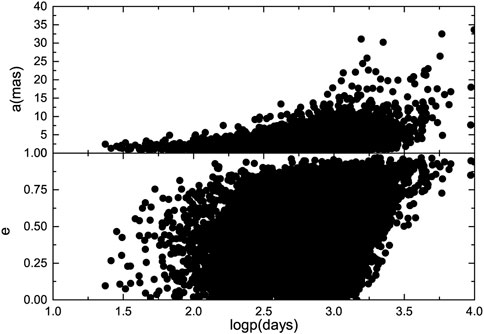
FIGURE 1. Top panel: The angular semi-major axes as a function of the orbital period for the systems. Bottom panel: The eccentricity as a function of the orbital period for the systems.
The orbital motion of the visual components superimposed on the proper motion, can be expressed with the following equation:
Where x0, y0 represent the position with respect to the coordinate origin at the primary. μx and μy represent the proper motion of these systems adapted from the tboasb1c.dat document of Gaia DR3 Part 3 (Gaia collaboration, 2022). The coefficients A, B, F, and G are the Thiele-Innes constants:
And
Where a, i, Ω, ω, e, P, T indicate the semi-major axis of the photocentric orbit which is in accordance with the primary orbit, the inclination, the latitude of the ascending node, the argument of the periastron, the eccentricity, the period, and the time of passage at periastron.
The simulated position data are randomly distributed in the 10 years survey of CSST with 1 mas uncertainty. 10, 20, and 100 data points at different observing time are considered to be simulated according to Eqs 1–3. 10 and 20 data points are used to indicate systems observed in the deeper field, and 100 data points are used to indicate systems observed in the extreme-deep field of CSST. For simplicity, when we fit the simulated CSST data, we consider a, i, Ω as the adjusted parameters and keep other parameters unchanged. The uncertainties for the derived parameters are determined from the covariance matrix. The distribution of δa/a, δi and δΩ by adding 10, 20, 100 simulated CSST data are shown in Figures 2–4. We suppose that the parameter distribution of these systems is in accordance with the SB1s that can be detected by CSST. From the statistical results, it only needs 10 observing data to give the preliminary orbital solutions of majority systems. When the observing data reach 100, the orbital solutions of majority systems can be well determined. It means that the solutions of SB1s in the deeper field of CSST can be determined preliminarily, and the orbital solutions of the SB1s in the extreme-deep field can be well determined. Therefore, CSST will contribute a lot to providing orbital solutions of SB1s. In Figure 5, the reference apparent orbit and the fitted apparent orbit of Gaia DR3 1008179186883570304 as well as the simulated CSST data were shown. From the Figure, we can see that the fitted apparent orbit is basically consistent with the reference apparent orbit by fitting the simulated CSST data. The original parameters a, i and Ω are 12.1778 mas, 113.3809° and 34.5774°, respectively. By fitting simulated CSST data, the parameters a, i and Ω are determined as 12.31 ± 0.15 mas, 114.08 ± 0.77° and 34.28 ± 0.30°, respectively.
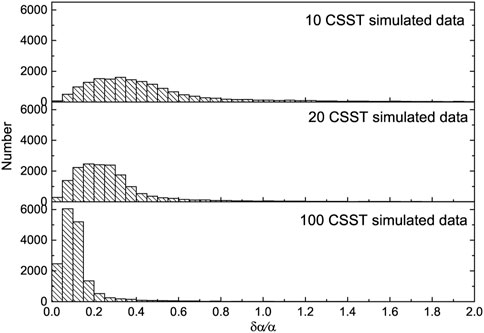
FIGURE 2. The distribution of the relative precision of angular semi-major axes of the primary. The panels represent the precision by fitting 10, 20, 100 simulated CSST data from the top to the bottom, respectively.
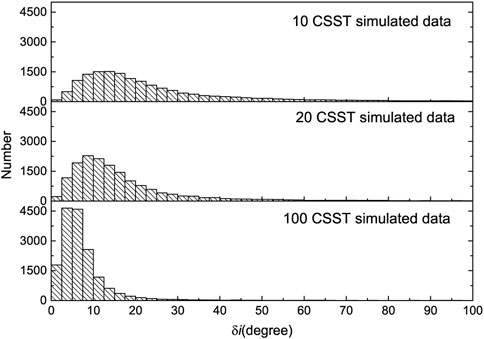
FIGURE 3. The distribution of the precision of inclination. The panels represent the precision by fitting 10, 20, 100 simulated CSST data from the top to the bottom, respectively.
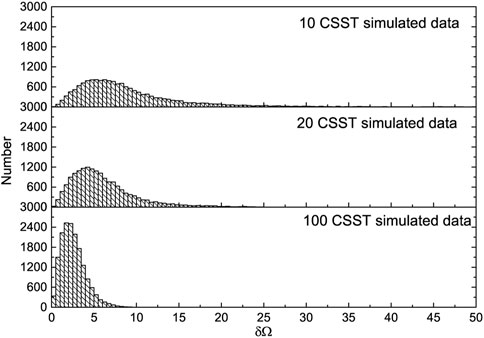
FIGURE 4. The distribution of δΩ. The panels represent the precision by fitting 10, 20, 100 simulated CSST data from the top to the bottom, respectively.
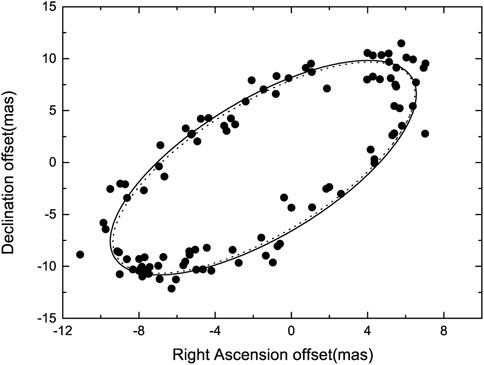
FIGURE 5. The dot line and the solid line represent the reference apparent orbit and the fitted apparent orbit of Gaia DR3 1008179186883570304, respectively. The black dot represent the simulated CSST data.
3 Concluding remarks
The sky area will be observed at least 8 or 16 times for the deeper field surveys, and it will be observed for more than 100 times for the extreme-deep field surveys of CSST in 10 years. The fitting of the simulated CSST data at different observation times during 10 years at 1 mas precision indicates that CSST has the ability to determine the orbital solutions of SB1s which can be detected, especially for the systems in the extreme-deep field. Although the orbital solutions of most systems in the deeper field cannot be well determined, preliminary solutions can be given for the guiding of further observation.
The observable magnitude of CSST is generally not brighter than 17 mag, while the systems of our sample are brighter than that can be detected by CSST. Therefore, the following work will focus on the collection of SB1s and SB1 candidates fainter than 17 mag in the deeper field surveys and extreme-deep field surveys of CSST. Large-scale spectroscopic survey project as LAMOST, SEGUE and Gaia-ESO survey can detect SB1s fainter than 17 mag (Yanny et al., 2009; Gilmore et al., 2012; Zhao et al., 2012). Once time series data of Gaia and CSST data were released in the future, these systems with astrometric orbital solutions will be enlarged evidently by fitting these data with a much longer time baseline.
Meanwhile, the fitting model of various data with long-time baseline will be developed and optimized. At present, most of the SB1s with complete orbital solutions have relatively short orbital periods. In combination of the present data, Gaia and CSST data, the astrometric orbital solutions of a large number of SB1s with longer orbital periods will be determined.
Data availability statement
The raw data supporting the conclusion of this article will be made available by the authors, without undue reservation.
Author contributions
XW contributed to conception, design of the study, writing original draft preparation. YF and FX contributed to methodology, validation. All authors contributed to manuscript revision, read, and approved the submitted version.
Funding
The Natural Science Foundation of Shandong Province of China (Grant No. ZR202102220686), the National Natural Science Foundation of China (Grant No. 11603072, 11727806, 11673071, and 12073008), the science research grants from the China Manned Space Project (Grant No. CMS-CSST-2021-A12, CMS-CSST-2021-B10).
Acknowledgments
This research has made use of the SIMBAD astronomical literature database, operated at CDS, Strasbourg, France. This work has made use of data from the European Space Agency (ESA) mission Gaia (https://www.cosmos.esa.int/gaia), processed by the Gaia Data Processing and Analysis Consortium (DPAC, https://www.cosmos.esa.int/web/gaia/dpac/consortium). Funding for the DPAC has been provided by national institutions, in particular the institutions participating in the Gaia Multilateral Agreement.
Conflict of interest
The authors declare that the research was conducted in the absence of any commercial or financial relationships that could be construed as a potential conflict of interest.
Publisher’s note
All claims expressed in this article are solely those of the authors and do not necessarily represent those of their affiliated organizations, or those of the publisher, the editors and the reviewers. Any product that may be evaluated in this article, or claim that may be made by its manufacturer, is not guaranteed or endorsed by the publisher.
Footnotes
1The Gaia id and orbital parameters of the 16805 systems are provided as supplementary materials.
References
Birko, D., Zwitter, T., Grebel, E. K., Parker, Q. A., Kordopatis, G., Bland-Hawthorn, J., et al. (2019). Single-lined spectroscopic binary star candidates from a combination of the rave and gaia dr2 surveys. Astronomical J. 158, 155. doi:10.3847/1538-3881/ab3cc1
Cao, Y., Gong, Y., Meng, X.-M., Xu, C. K., Chen, X., Guo, Q., et al. (2018). Testing photometric redshift measurements with filter definition of the Chinese space station optical survey (css-os). Mon. Notices R. Astronomical Soc. 480, 2178–2190. doi:10.1093/mnras/sty1980
Esa (1997). Vizier online data catalog: The hipparcos and tycho catalogues (esa 1997). VizieR Online Data Catalog , I/239 .0E.
Fu, Z., Qi, Z., Liao, S., Peng, X., Yu, Y., Wu, Q., et al. (2023). Simulation of CSSTs astrometric capability. arXiv e-prints , arXiv:2304.02196. doi:10.48550/arXiv.2304.02196
Gilmore, G., Randich, S., Asplund, M., Binney, J., Bonifacio, P., Drew, J., et al. (2012). The gaia-ESO public spectroscopic survey. Messenger 147, 25–31 25G.
Gong, Y., Liu, X., Cao, Y., Chen, X., Fan, Z., Li, R., et al. (2019). Cosmology from the Chinese space station optical survey (css-os). astrophysical J. 883, 203. doi:10.3847/1538-4357/ab391e
Jancart, S., Jorissen, A., Babusiaux, C., and Pourbaix, D. (2005). Astrometric orbits ofSB9 stars. Astronomy Astrophysics 442, 365–380. doi:10.1051/0004-6361:20053003
Kürster, M., Endl, M., and Reffert, S. (2008). A probable close Brown dwarf companion to GJ 1046 (M 2.5V). Astronomy Astrophysics 483, 869–874. doi:10.1051/0004-6361:200809419
Merle, T., Swaelmen, M., Eck, S. V., Jorissen, A., Jackson, R. J., Traven, G., et al. (2020). The gaia-eso survey: Detection and characterisation of single-line spectroscopic binaries. Astronomy Astrophysics 635, A155. doi:10.1051/0004-6361/201935819
Pourbaix, D., and Boffin, H. M. J. (2003). Reprocessing the hipparcos intermediate astrometric data of spectroscopic binaries. ii. systems with a giant component. Astronomy Astrophysics 398, 1163–1177. doi:10.1051/0004-6361:20021736
Pourbaix, D., Tokovinin, A. A., Batten, A. H., Fekel, F. C., Hartkopf, W. I., Levato, H., et al. (2022). Gaia data release 3. summary of the content and survey properties.
Pourbaix, D., Tokovinin, A. A., Batten, A. H., Fekel, F. C., Hartkopf, W. I., Levato, H., et al. (2004). SB9: The ninth catalogue of spectroscopic binary orbits. ninth catalogue Spectrosc. Bin. orbits 424, 727–732. doi:10.1051/0004-6361:20041213
Gaia Collaboration Prusti, T., de Bruijne, J. H. J., Brown, A. G. A., Vallenari, A., Babusiaux, C., et al. (2016). The gaia mission. Astronomy&Astrophysics 595, A1. doi:10.1051/0004-6361/201629272595A
Qian, S. B., Liao, W. P., Shi, X. D., Zhu, L. Y., Li, L. J., Zhang, J., et al. (2019). More than two hundred and fifty thousand spectroscopic binary or variable star candidates discovered by lamost. Res. Astronomy Astrophysics 19, 064. doi:10.1088/1674-4527/19/5/64 19.
Ren, S., and Fu, Y. (2013). Hipparcos photocentric orbits of 72 single-lined spectroscopic binaries. Astronomical J. 145, 81. doi:10.1088/0004-6256/145/3/81
Ren, S., and Fu, Y. (2010). Orbit determination of double-lined spectroscopic binaries by fitting the revised hipparcos intermediate astrometric data. Astronomical J. 139, 1975–1982. doi:10.1088/0004-6256/139/5/1975
Stefanik, R. P., Torres, G., Latham, D. W., Landsman, W., Craig, N., and Murrett, J. (2011). Observations and orbital analysis of the giant white dwarf binary system hr 5692. Astronomical J. 141, 144. doi:10.1088/0004-6256/141/5/144
Tian, Z., Liu, X., Yuan, H., Fang, X., Chen, B., Xiang, M., et al. (2020). A catalog of rv variable star candidates from lamost. Astrophysical J. Suppl. Ser. 249, 22. doi:10.3847/1538-4365/ab9904
van Leeuwen, F. (2007). Validation of the new hipparcos reduction. Astronomy&Astrophysics 474, 653–664. doi:10.1051/0004-6361:20078357
Yanny, B., Rockosi, C., Newberg, H. J., Knapp, G. R., Adelman-McCarthy, J. K., Alcorn, B., et al. (2009). Segue: A spectroscopic survey of 240,000 stars with g = 14-20. Astronomical J. 137, 4377–4399. doi:10.1088/0004-6256/137/5/4377.137.4377Y
Zhan, H. (2011). Consideration for a large-scale multi-color imaging and slitless spectroscopy survey on the Chinese space station and its application in dark energy research. Sci. Sinica Phys. Mech. Astronomica 41, 1441–1447. doi:10.1360/132011-961
Zhan, H., and Tyson, J. A. (2018). Cosmology with the large synoptic survey telescope: An overview. Rep. Prog. Phys. 81, 066901. doi:10.1088/1361-6633/aab1bd
Keywords: CSST, numerical simulation, binary, SB1, orbital solution
Citation: Wang X, Xia F, Fu Y and Chen Y (2023) The ability of CSST to determine the orbital solutions of SB1s. Front. Astron. Space Sci. 10:1152894. doi: 10.3389/fspas.2023.1152894
Received: 28 January 2023; Accepted: 05 May 2023;
Published: 18 May 2023.
Edited by:
Shilong Liao, Chinese Academy of Sciences (CAS), ChinaReviewed by:
Zhaoxiang Qi, Chinese Academy of Sciences (CAS), ChinaMing Yang, Tongji University, China
Copyright © 2023 Wang, Xia, Fu and Chen. This is an open-access article distributed under the terms of the Creative Commons Attribution License (CC BY). The use, distribution or reproduction in other forums is permitted, provided the original author(s) and the copyright owner(s) are credited and that the original publication in this journal is cited, in accordance with accepted academic practice. No use, distribution or reproduction is permitted which does not comply with these terms.
*Correspondence: Xiaoli Wang, d3hsYnl5YXRiQDE2My5jb20=
 Xiaoli Wang
Xiaoli Wang Fang Xia
Fang Xia Yanning Fu2
Yanning Fu2